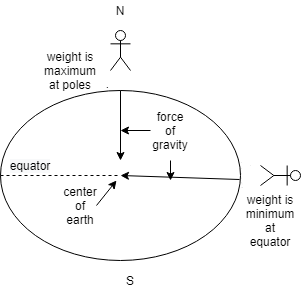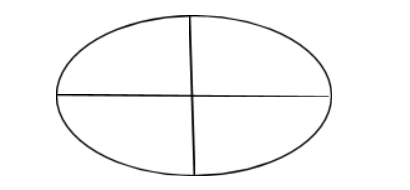
The value of acceleration due to gravity _____as we move from equator to pole.
A) Increases
B) Decreases
C) Remains the same
D) Become zero
Answer
573.6k+ views
Hint: As we all know that earth is not a perfect sphere. It is actually an ellipse shape. The gravity kept on changing as we moved from one place to another. But it is maximum at the place where it is nearer to the center. The center of the earth lets be $O$ and we all know that an ellipse the longest diameter is the major axis goes through the center $O$ and the minor axis is the shortest.
Complete step by step answer:
Step 1:
The earth is not a perfect sphere. It is in an oval shape similar to the ellipse that’s why the gravity is not the same in each and every part of the earth. It is maximum at the place which is nearer to the center. So, the earth is kind of an ellipse and the equator is further away from the center of mass of the earth than at the poles. So, as we go from the equator to poles, the value of g increases.
Step 2:
In the SI unit the acceleration is measured as in $\dfrac{m}{{{s^2}}}$. Near the earth’s surface, the acceleration due to gravity is $9.8 \dfrac{m}{{{s^2}}}$, which means that if we ignore the effect of resistance by air, the speed of an object falling will be $9.8$ meters per second.
The weight of an object on earth’s surface is the downwards force on that object, given by Newton’s second law of motion, $F=ma$ (force is equal to the product of mass and acceleration).
The gravitational acceleration contributes to the total gravity and rotation of the earth also.
Step 3:
To understand we must know about the ellipse and also a diagram is given below for better understanding.

Here in the diagram, we can see that an actor or a man is standing in the equator and at the poles. Since the distance at the poles is smaller than that of the equator hence we can say that person has more acceleration due to gravity on the poles than the equator.
The value of acceleration due to gravity increases as we move from equator to pole. Therefore, option (A) is correct.
Note:
An ellipse is a plane curve surrounding two focal points such that for all points on the curve the sum of two distances to the focal points is a constant. As such it generalizes a circle, which is the special type of an ellipse in which the two focal points are the same.

Area of ellipse =$\pi ab$ where a and b are the axis of an ellipse
Complete step by step answer:
Step 1:
The earth is not a perfect sphere. It is in an oval shape similar to the ellipse that’s why the gravity is not the same in each and every part of the earth. It is maximum at the place which is nearer to the center. So, the earth is kind of an ellipse and the equator is further away from the center of mass of the earth than at the poles. So, as we go from the equator to poles, the value of g increases.
Step 2:
In the SI unit the acceleration is measured as in $\dfrac{m}{{{s^2}}}$. Near the earth’s surface, the acceleration due to gravity is $9.8 \dfrac{m}{{{s^2}}}$, which means that if we ignore the effect of resistance by air, the speed of an object falling will be $9.8$ meters per second.
The weight of an object on earth’s surface is the downwards force on that object, given by Newton’s second law of motion, $F=ma$ (force is equal to the product of mass and acceleration).
The gravitational acceleration contributes to the total gravity and rotation of the earth also.
Step 3:
To understand we must know about the ellipse and also a diagram is given below for better understanding.

Here in the diagram, we can see that an actor or a man is standing in the equator and at the poles. Since the distance at the poles is smaller than that of the equator hence we can say that person has more acceleration due to gravity on the poles than the equator.
The value of acceleration due to gravity increases as we move from equator to pole. Therefore, option (A) is correct.
Note:
An ellipse is a plane curve surrounding two focal points such that for all points on the curve the sum of two distances to the focal points is a constant. As such it generalizes a circle, which is the special type of an ellipse in which the two focal points are the same.

Area of ellipse =$\pi ab$ where a and b are the axis of an ellipse
Recently Updated Pages
Why are manures considered better than fertilizers class 11 biology CBSE

Find the coordinates of the midpoint of the line segment class 11 maths CBSE

Distinguish between static friction limiting friction class 11 physics CBSE

The Chairman of the constituent Assembly was A Jawaharlal class 11 social science CBSE

The first National Commission on Labour NCL submitted class 11 social science CBSE

Number of all subshell of n + l 7 is A 4 B 5 C 6 D class 11 chemistry CBSE

Trending doubts
What is meant by exothermic and endothermic reactions class 11 chemistry CBSE

10 examples of friction in our daily life

One Metric ton is equal to kg A 10000 B 1000 C 100 class 11 physics CBSE

1 Quintal is equal to a 110 kg b 10 kg c 100kg d 1000 class 11 physics CBSE

Difference Between Prokaryotic Cells and Eukaryotic Cells

What are Quantum numbers Explain the quantum number class 11 chemistry CBSE




